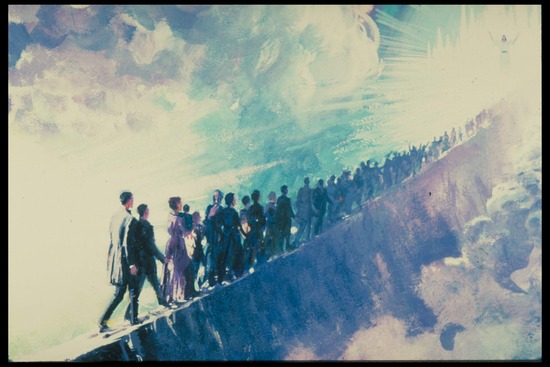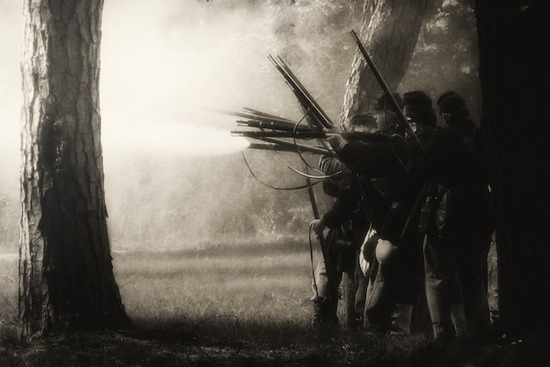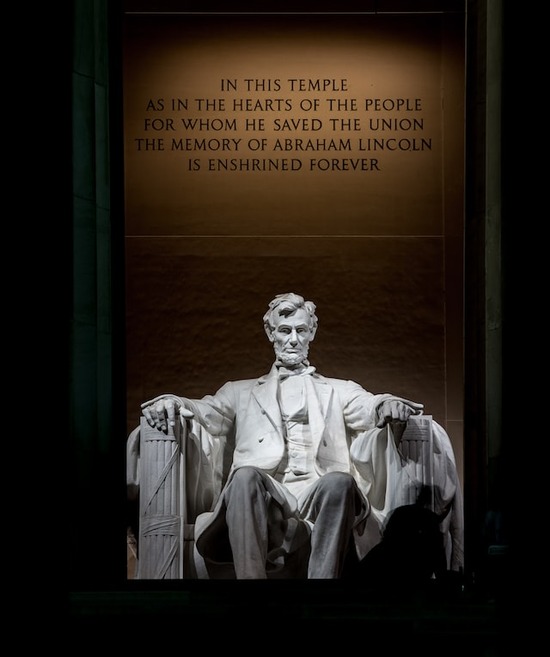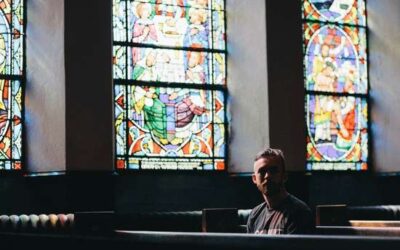While the visions God gave Ellen White were often about the distant future or last-day events, she had many others that addressed different topics. They may not be discussed as much as her visions about the Second Coming or the End Times, but they tackled some timely topics for her day.
And you might be surprised just how much wisdom we can gain from reading about them today.
So let’s look at some of the prophetic visions she had about major events and issues of her time:
- What happened when Ellen White received a vision
- The Civil War
- Slavery and abolition
- Temperance and health reform
- Improving the dress
- The San Francisco earthquake
- What can we learn from these visions?
Let’s first see what her visions were like in general.
What her visions were like

Courtesy of the Ellen G. White Estate, Inc.
Ellen White’s first vision occurred in December of 1844, while she was praying in a friend’s home. In it, she saw Advent believers, led by Jesus, traveling toward the New Jerusalem,1 or God’s city that will descend from heaven to earth after the Millennium.
This was the start of Ellen White’s ministry, which grew into the Adventist Church. She had many more visions in life, such as the Investigative Judgment, end-time events, and heaven.
Many of them happened in the middle of the day, and it would be evident to those around her that something was happening! There were also some that came to her at night.
Some would last only a few minutes, others were hours long. Her longest vision, the Ellen G. White Estate says, was four hours long.2
Many people witnessed Ellen White “go into” vision. Her son, “Willie” White, witnessed many. Of one in particular, he said that “as she was praying, I heard that shout, Glory. There is nothing like it—that musical, deep shout of Glory.”3
Another witness to her visions, M. G. Kellogg, said, “I am quite certain that she did not breathe at that time while in vision, nor in any of several others which she has had when I was present.”
Many others had seen her in vision and expressed similar observations.
Now let’s take a look at some of the visions Ellen White had about events in her time.
The Civil War
Never before had the nation been so belligerently divided. And during this time of upheaval and uncertainty, Ellen White received three visions over a period of about a year.
Predicting its soon arrival
On January 12, 1861, Ellen and James White were visiting the church in Parkville, Michigan. She had her first war vision here.4
The vision lasted about 20 minutes. When she came out of it, she had sorrow to report:
“People are making sport of the secession of South Carolina, but I have just been shown that a large number of states are going to join that state and there will be a most terrible war.”
She may not have known at the time that Mississippi, Florida, and Alabama had seceded just days before her vision.5
She also saw “the field after battle, all covered with the dead and dying. Then I was carried to prisons, and saw the sufferings of those in want, who were wasting away. Then I was taken to the homes of those who had lost husbands, sons, or brothers in the war. I saw there distress and anguish.”6
While there were some who had speculated the possibility of a war, the prevailing opinion at the time either dismissed the idea or figured it would be a short-lived conflict.
The South seceded temporarily (they thought) because they believed they could make a better decision outside the Union. They also doubted that the North would go through all the trouble to start a war.7
The North believed the South was too timid to start a war, not to mention woefully underprepared.8 They believed that, in Horace Greeley’s words, “a few old women with broomsticks could go down there and beat out all their rebellion!”9
Even when the first shots at Fort Sumter were fired, the North firmly believed the revolt would end quickly. After all, Abraham Lincoln asked for only 75,000 volunteers and signed them on for only 3 months.10
And so Ellen White’s vision was confirmed within a short time. Texas, Louisiana, and Georgia soon followed the other Southern states, and Virginia, Arkansas, Tennessee, and North Carolina severed ties later. These eleven states became the Confederate States of America.
Just three months after she saw the battlefields, on April 15, South Carolina militia fired on Fort Sumter, starting the war.
The battle of Bull Run

Photo by Scott Umstattd on Unsplash
On July 21, 1861, the first major battle of the War occurred, the battle of Bull Run (or Manassas), near Washington, D.C. A couple weeks later, Ellen White was attending a Seventh-day Adventist conference in Roosevelt, New York, when she received another vision.
Many concepts of the War were shown to her by God. By far, the most important one concerned the battle itself. “I had a view of the disastrous battle at Manassas, Virginia. It was a most exciting, distressing scene,” she recorded in Testimonies For the Church, vol. 1.
“The dead and dying were on every side. Both the North and the South suffered severely. The Southern men felt the battle, and in a little while would have been driven back still further. The Northern men were rushing on, although their destruction was very great.”11
The predictions of the “dead and dying” in her first vision were already coming to pass.
“Just then an angel descended, and waved his hand backward. Instantly there was confusion in the ranks. It appeared to the Northern men that their troops were retreating, when it was not so in reality, and a precipitate retreat commenced.”12
Most historians agree that the retreat of the Union troops was a mysterious element in the battle. The lines were clear and orderly, and then, as Lt. Colonel W.W. Blackford recorded, “suddenly [they] became like a confused swarm of bees, running away as fast as they could.”13
In this vision, Ellen White was also told that people who expected a short war would be grievously disappointed.14 Everyone knows that the Civil War became a long, bloody affair.
God told Ellen White, as well, of the evils of slavery, which we’ll see a bit later.
Third vision
On January 4, 1862, Ellen White was again given a vision. This one pertained to the nation as a whole.
The main points of this vision included:
- President Buchanan (the president before Lincoln) allowed the South to steal Northern weapons to arm themselves against any coming conflict with the North.15
- The North boasted of their strength and ability to squash the rebellion, when they had no idea how prepared the South was to defend their cause to the death.16
- Even though the North claimed the War’s reason was to uphold the Union, slavery was the root cause.17
- The North was no closer to winning the War after a whole year than they were at the start.18
- Some Northern commanders secretly sided with the South. They purposely placed anti-slavery men in the fiercest parts of combat to have them forever silenced.
Many of these things Ellen White saw came to pass. It’s now a very common point of view that the whole point of the Civil War was to end slavery, while preservation of the Union was still a concern, but it was mostly the equivalent of a slogan.
We also have seen from many historical accounts that the South had far more grit and determination than ever imagined at the time.
Buchanan’s presidency was riddled with disastrous scandals, not the least of which included sending arms to the South, in case of a conflict.19
And it did indeed take the North much more than a year to stop the War.
The vision included further particulars about slavery, which we’ll look at next.
Slavery and its abolition

Photo by Casey Horner on Unsplash
The issue of black slaves being forced to work on Southern plantations rose up in the 1800s and cracked the United States in two. Southerners felt they could not do without slaves, while abolitionists in the North worked to free the slaves.
While large Protestant churches, like the Methodists, Presbyterians, and Baptists, were also split by the conflict, Adventists took the position that slavery was evil and should be opposed on all counts.
Before the Civil War, Adventism had spread west but not south. They were in line with Union sentiment and were “rigidly anti-slavery.”20
Ellen White and church leaders did not take part in governmental affairs or demonstrations regarding abolition,21 but she had many opinions regarding slavery.
- Slavery, she said, was a “grievous and enormous sin.”22 It was of Satan.
- Human beings cannot be the property of any master but Jesus.23
- Men should disregard the Fugitive Slave Act, which required anyone who found an escaped slave to return him to his master.24 The Fugitive Slave Act contradicted Deuteronomy 23:15, which prohibits an escaped slave from being returned to his master.
What her visions revealed
Much of Ellen White’s second Civil War vision addressed the issue of slavery directly.
Some of it confirmed views she—and the Church—already held: Slavery was an awful sin that robbed human beings of dignity, and laws supporting it contradicted the teachings of Jesus Christ.25
Her vision revealed that the Civil War was the unfolding consequences of the country’s decisions. The South was seeing the effects of continuing an abhorrent practice, and the North was dealing with the fallout of letting it go on so long unchecked.26
These revelations, in detail, were published in a series of war articles in the Review and Herald.27
The vision revealed two major things: First, God is extremely interested in the oppressed and will help the helpless. Second, it’s a Christian’s responsibility to involve themselves in these matters.28
Ellen White’s third vision on the Civil War showed more about the nation as a whole. She recorded that England would have aligned herself with the North, had the Union fought the war on the basis of slavery.29
England herself had abolished slavery earlier in the century.
Since the Union was more concerned about preserving itself early on, England turned to its own interests and considered uniting with the Southern cause.30 Cotton production tied England economically to the South.
She also saw that the days of fasting and prayer on behalf of the Union were like an insult to God because slavery was not named the main reason for the Northern fight. The real sin was still not being admitted.31
Her final dark warning promised that the nation would be further “humbled into the dust.”32
And so it was. Not until Abraham Lincoln signed the Emancipation Proclamation, freeing all slaves, did the tide turn for the North.
Temperance and health reforms
Surrounding the Civil War, the Church received other counsel through Ellen White’s visions. As early as 1848, she received a vision about health reform. However, much of the matter was addressed in a vision she saw on June 5, 1863 and another in 1865.
America was a self-destructing people
In the 1800s, people were extremely unhealthy.
Their diet was unbalanced. They consumed vast quantities of meat, salt, and rich foods, and few fruits and vegetables.
Most people drank and smoked, and it was also common to overwork themselves.
Diseases we would hardly give a second thought to today, like diphtheria, cholera, measles, and consumption (tuberculosis), were rampant then.
Doctors knew little “real” medicine. They blood-let their patients, used unsanitary instruments, and prescribed “medicine” of poisonous drugs and liquids containing high amounts of alcohol.
And on top of it all, the typical dress of the day involved constricting, impractical clothing, which we’ll look at later on.
The vision that inspired reform

Courtesy of the Ellen G. White Estate, Inc.
In the fall of 1848, an angel of God instructed Ellen White with information to help avoid common health issues associated with common products. She learned that black tea, coffee, and tobacco were harmful substances.33
Later, in 1854, she was told that personal hygiene was a problem among the Seventh-day Adventist Church, as was self-control regarding their appetites.34
“I then saw a lack of cleanliness among Sabbathkeepers,” she recorded in Selected Messages Book 3. “…Our souls, bodies, and spirits are to be presented blameless by Jesus to His Father, and unless we are clean in person, and pure, we cannot be presented blameless to God.”35
Of self-control, she wrote, “I saw that many were sickly among the remnant who have made themselves so by indulging their appetites. If we wish good health, we must take special care of the health that God has given us, deny the unhealthy appetite, eat less fine food, eat coarse food free from grease.”36
Then, in 1863, “the great subject of health reform was opened before me [Ellen White] in vision.”37 The vision lasted approximately 45 minutes. In it, she received guidance for her husband’s illness, along with general principles for the church.
“The present corrupt state of the world was presented before me. The sight was terrible,” she wrote of the vision in Spiritual Gifts, Volume 4. “…The first great evil was intemperance in eating and drinking. Men and women have made themselves slaves to appetite.”38
Later, on Christmas Eve of 1865, she received another vision. In this, she was told to establish an Adventist institution to heal the sick.39 This became a reality with the Western Health Reform Institute, established in Battle Creek, Michigan, in 1866.40 Later, it became known as the Battle Creek Sanitarium.
The institution marked a new era for Adventists, and became the first of many church-operated hospitals, clinics, and health institutions.
Ellen White had her own reasons to seek health reform. Her injury as a child left her disabled for many years. She said, “When the message of health reform first came to me, I was weak and feeble, subject to frequent fainting spells.”41
James White, Ellen’s husband, also suffered severe breakdowns in health. The vision of 1863, in part, gave treatment for his sickness.42
Others were realizing these things, too
The nation was only beginning to realize the detriments of their lifestyle when Ellen White had her visions.
The campaign for healthier living began with Sylvester Graham, an evangelist. He and others collected a basic idea for improving health. They advised a vegetarian diet, temperance, exercise, and no use of “medicine” from doctors.43
Millerites, like Joseph Bates, Ezekiel Hale, Jr., and Dr. Larkin B. Coles, also caught on to health reform and began promoting better living.44
10 categories of reform
In Ellen White’s 1863 vision, she was given ten areas of health to improve, which were outlined in the book, The Great Visions of Ellen G. White, by Roger W. Coon.
- Care of health is a Christian’s duty. Our bodies are God’s temples (1 Corinthians 6:19-20). (However, this does not mean that good health is a requirement to get to heaven.)45
- Disease is mostly caused by violating health laws. The Bible lays out many guidelines in the Old Testament for diet and cleanliness, which made the Israelites less susceptible to germs and viruses.46
- Temperance. While temperance societies usually attacked alcohol, Ellen White broadened the term to mean:
- Stimulating drinks like alcohol, tea, and coffee
- Tobacco in all its forms
- Highly-spiced (rich) foods, like meat, puddings, cakes, or gravies
- Indulgence in base passions, referring to promiscuous sexual relationships47
- Vegetarianism. The original diet of Adam and Eve was plant-based. The most healthful nutrients are found in fruits, vegetables, nuts, and whole grains.48
- Proper diet. Two main problems are eating between meals and eating too much at meals. Ellen White advocated for two meals a day. If supper was eaten, it should be lighter and consumed several hours before bed.49
- Control of the mind. People often imagine they’re ill when they’re actually fine—and vice versa. Mindfulness and self-awareness were not common practices in those days.50
- Natural health remedies. Medicines of the day often contained opium, mercury, strychnine, and laudanum. Ellen White’s natural remedies began with:
- Pure air
- Pure water
- Sunshine
- Physical exercise
- Adequate rest
- Fasting for short time periods to rest the stomach51
- Personal cleanliness, which included body, clothing, and living quarters.52
- Environmental concerns, which meant destroying rotting vegetation near the house and building on high ground, free from standing water, which bred mosquitoes and other ailments.53
- Health education. This was the church’s duty, and should focus on preventing illness.54
The Church turned to this new direction, and as people began to adopt these new practices, they found their health returning and improving.
Dressing for practicality
Ellen White also received visions concerning clothing. Mostly, this pertained to the fashion trends encouraged for women during the nineteenth century.
1800s women’s clothing
A well-to-do woman’s closet was likely to be a dizzying array of skirts, strings, undergarments, accessories, and cloth. Yards of fabric went into the making of one dress, which was accentuated by layers of undergarments and numerous bits of bows, lace, and ribbon.
Female fashion was created for the eye, not practicality.
Extravagant fashions, like bustles, hoops, collars, pockets, and leg-o-mutton sleeves, came in and out. Some things never left, but evolved through the century.
One of those was corsets. Worn by nearly every woman, this stiff garment, tied tightly in the back, was to mold the abdomen and waist into that classic “hour-glass” shape.
When tied loosely, the garment could actually be useful, as it supported the back. Worn tightly, as many in high society did, it caused faintness, difficulty breathing, and harm to the bones and organs of the abdomen.
In the 1860s, when Ellen White had her vision, enormous hoop skirts were “in.” These hoops were essentially cages that poofed out the skirt. Walking and maneuvering were difficult.
Another fashion of the time was long trains on the ends of dresses. When women walked, these dresses dragged on the ground, picking up mud, water, trash, discarded bits of food, and whatever else lay in their way.
Around this time also, Amelia Bloomer and others had come up with what was called “bloomers.” This loose dress, with skirts and pants, was proffered as the solution to women’s illnesses, egged on by health-destroying dress.55
Ellen White’s stance

When explaining her vision of reform, Ellen White went first to Scripture.
In the New Testament, 1 Timothy 2:9 says, “[I]n like manner also, that the women adorn themselves in modest apparel, with propriety and [a]moderation, not with braided hair or gold or pearls or costly clothing” (NKJV).
With this, she pointed out the impracticality of hoops, long dresses, tight corsets, and extravagant clothing. Instead, she promoted a modest way of dress.
However, she cautioned Adventists to dress with “order and taste” and “decency and neatness.” These things were not to be matters of vain pride.56
Building on this, she said, “Christians should not take pains to make themselves gazing-stocks by dressing differently from the world. But if, in accordance with their faith and duty in respect to their dressing modestly and healthfully, they find themselves out of fashion [as in by not wearing hoops], they should not change their dress in order to be like the world.”57
Balance and moderation was key. Modesty was the principle, regardless of the trends of the time.
Ellen White also pointed out people should not spend loads of money on needless accessories for personal pride or ambition. Clothing should be inexpensive, she said in The Ministry of Healing.58
Money spent on such frippery could feed the poor and satisfy the needy, she continued.59
These improved dress ideas weren’t as well-received as some of Ellen White’s other reforms. Unfortunately, it’s so easy to become slaves to fashion. But clothing eventually did reform, though independently from Ellen White’s suggestions. In the 1900s, hoops, heavy and long skirts, and corsets were all cut from women’s fashions because of the changing economy.
San Francisco earthquake
Probably the vision that was fulfilled the quickest was that of the San Francisco earthquake.
While visiting Loma Linda, Ellen White had a vision on April 16, 1906. She recorded seeing:
“Houses shaken like a reed in the wind. Buildings, great and small, were falling to the ground. Pleasure resorts, theaters, hotels, and the homes of the wealthy were shaken and shattered. Many lives were blotted out of existence, and the air was filled with the shrieks of the injured and the terrified.60
Two days later, on April 18, 1906, the San Andreas fault slipped over 270 miles. At 5:12 a.m., the earthquake struck San Francisco and surrounding communities. The earthquake itself did enough harm, but its aftermath reduced 500 city blocks to charred rubble.
Underneath the cracked streets, gas lines snapped like toothpicks. Fires broke out and built to a raging inferno that was six times as large as the London fire of 1666.
Citizens and firemen battled the fires, while many people selected what few possessions they could carry or push and fled.
The fires lasted 72 hours, leaving 225,000 homeless, 800 dead, and 1,500 injured.61
That day, April 18, Ellen White was in Los Angeles. She heard newsboys shouting the news of San Francisco’s earthquake, and she read the story with “a heavy heart.”62
What can we learn from her words today?
Ellen White’s visions about events happening during her own time might not seem very relevant to our 21st century minds.
But some lessons and principles are timeless. There’s always wisdom to find.
First of all, we as human beings learn from the past. Why else do we study history? We learn from hearing about others’ past mistakes, methods, inventions, advances, and so forth. We study what has happened in similar situations before so that we can know how to prepare for or handle a similar situation in the future.
We read in the Bible of prophecies that were fulfilled, and we can see through Ellen White’s visions about the past that they came true as well.
Ellen White’s past visions also show us how much she and God cared for the smaller things as well. The Civil War, while terrible in its day, was still a localized conflict, and nothing in comparison to eternal life and death. Yet her visions helped people see the true motives and reasons behind the war.
The information she was given about improving health also helped ease everyday suffering, too. By cutting down on harmful foods, combinations, habits, or substances, the people of her day could eliminate many basic ailments like weight gain, indigestion, sickly children, fatigue, and more.
And these are the same health issues discussed today! It’s not difficult to find dozens of articles about being mindful of what you eat and how you eat it. You can also find plenty of advice about dressing modestly and considering your motives behind buying your clothes.
When it all comes down to it, it’s about looking for the truth in any matter. We aim to stop harmful behavior, no matter what society says.
Her messages can be applied to us now and help us improve our daily lives, over one hundred years later.
Related Articles
- https://lineagejourney.com/read/ellen-white-first-vision-and-call-to-ministry. [↵]
- “Longest Vision of Ellen G. White,” Andrews University and Fletcher Academy. [↵]
- White, W. C., “The Visions of Ellen White,” https://whiteestate.org/legacy/issues-visionsofegw-html/. [↵]
- White, W. C., White, A.L., Robinson, D. E., “The Spirit of Prophecy and Military Service,” whiteestate.org/legacy/issues-militaryservice-html/. [↵]
- https://lineagejourney.com/read/slavery-the-civil-war-and-ellen-white. [↵]
- Coon, p.79. [↵]
- White, White, and Robinson. [↵]
- Ibid. [↵]
- Coon, p. 81. [↵]
- White, White, and Robinson. [↵]
- White, Ellen Gould. Testimonies of the Church, vol. 1, pp. 266-267. [↵]
- Ibid. [↵]
- “Slavery, the Civil War, and Ellen White.” [↵]
- Coon, p. 83. [↵]
- Ibid, p. 86 [↵]
- Ibid. [↵]
- Ibid. [↵]
- Ibid. [↵]
- https://www.essentialcivilwarcurriculum.com/james-buchanan.html/. [↵]
- White, White, and Robinson. [↵]
- https://whiteestate.org/legacy/issues-voting-html/ [↵]
- O’Reggio, Trevor. “Slavery, Prophecy, and the American Nation as Seen by the Adventist Pioneers, 1854-1865,” Journal of the Adventist Theological Society, (Autumn 2006), p. 154. [↵]
- Ibid, p. 154-155. [↵]
- https://www.history.com/topics/black-history/fugitive-slave-acts [↵]
- Coon, p.83. [↵]
- Ibid. [↵]
- White, White, and Robinson. [↵]
- “Slavery, the Civil War, and Ellen White.” [↵]
- Coon, p.86. [↵]
- Ibid. [↵]
- Ibid. [↵]
- Ibid. [↵]
- Coon, Roger W. The Great Visions of Ellen G. White, p. 92. [↵]
- Ibid. [↵]
- White, Ellen G, Selected Messages, Book 3, p. 273. [↵]
- Ibid, p. 274. [↵]
- “Health Reform Vision,” http://office.simpleupdates.com/DiggingForTruth/article/128/prophecy/spirit-of-prophecy-section/visions-of-ellen-g-white/health-reform-vision-june-1863.html?id=128. [↵]
- White, Ellen G. Spiritual Gifts, vol. 4a, p.131. [↵]
- O’Hagan, “Health Reform: the Arm of Seventh-day Adventism,” Accessed 28 November 2022, https://eportfolios.macaulay.cuny.edu/kohagan12/thesis/health-reform-the-arm-of-seventh-day-adventism/. [↵]
- Ibid. [↵]
- “Health Reform Vision,” ibid. [↵]
- O’Hagan; Ibid. [↵]
- Ibid. [↵]
- Ibid. [↵]
- Coon, p. 93. [↵]
- Ibid. [↵]
- Ibid, pp. 94-95. [↵]
- Ibid., pp. 95-96. [↵]
- Ibid., p. 96. [↵]
- Ibid. [↵]
- Ibid. [↵]
- Ibid., p. 97. [↵]
- Ibid. [↵]
- Ibid. [↵]
- https://whiteestate.org/legacy/issues-dressref-html/#The%20Influence%20of%20the%20%22American%20Costume%22. [↵]
- Ibid. [↵]
- Ibid. [↵]
- White, Ellen Gould, The Ministry of Healing, p. 287. [↵]
- Ibid. [↵]
- White, Ellen G., Country Living, p. 8. [↵]
- https://www.ellengwhitetruth.com/her-ministry/the-test-results. [↵]
- “Earthquake Vision,” ibid. [↵]
More Answers
Ellen G. White’s Time in Europe
When the Seventh-day Adventist Church was still young, a council of the church in Europe requested Ellen White, one of Adventism’s key leaders, to come to Europe. Despite the many obstacles, God led her there to help the new churches and members for two years.
Ellen G. White’s Time in Australia
Ellen White traveled to Australia in the later part of her life, and she ended up spending nine years there. In that time, she helped the Australian Seventh-day Adventist Church increase in size and strength.
Can I Be an Adventist If I Don’t Believe in Ellen White?
Ellen White is an important part of the Seventh-day Adventist Church: she played a significant role in its founding, provided biblical support for several key doctrines, and continues to inspire church members today with her insightful counsel.
Didn’t find your answer? Ask us!
We understand your concern of having questions but not knowing who to ask—we’ve felt it ourselves. When you’re ready to learn more about Adventists, send us a question! We know a thing or two about Adventists.






